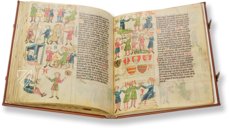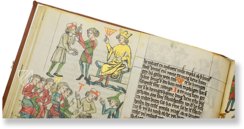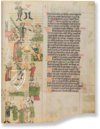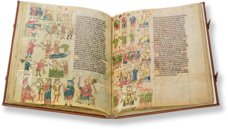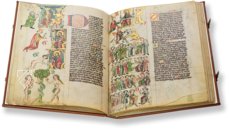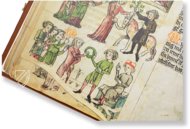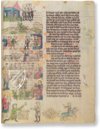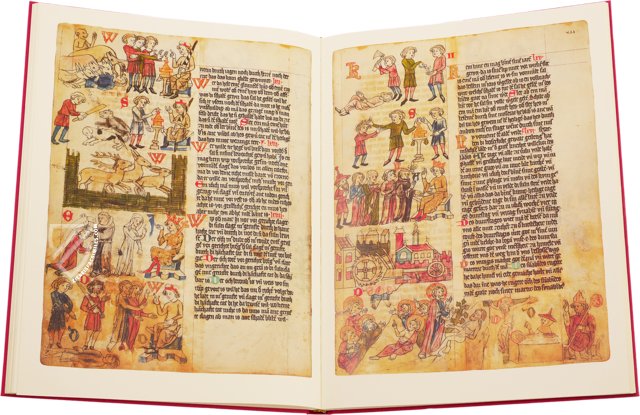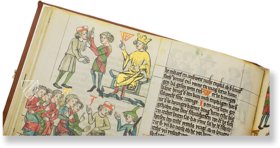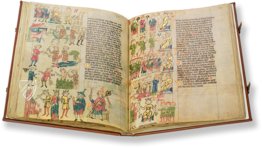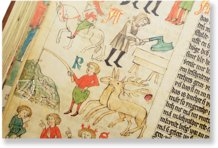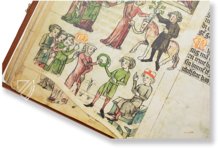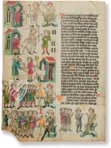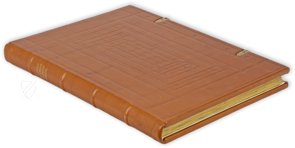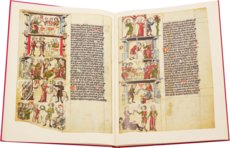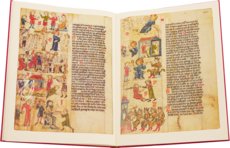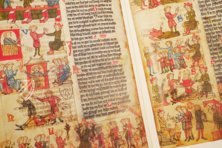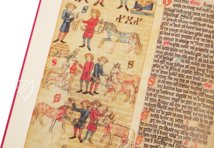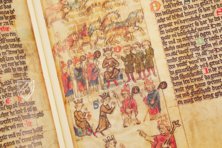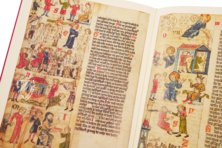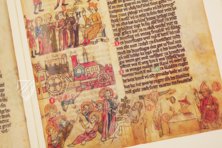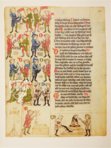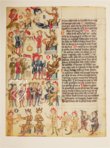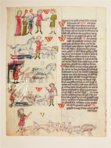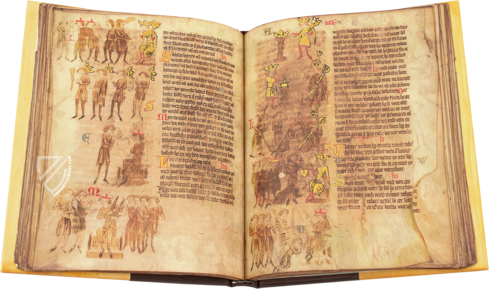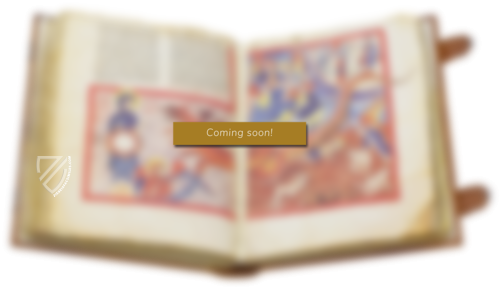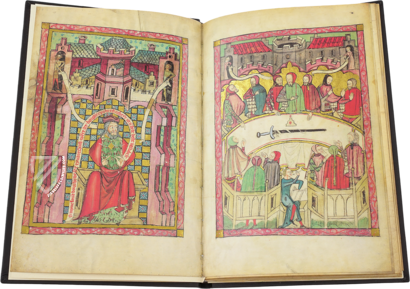Wolfenbüttel Mirror of Saxony
(1,000€ - 3,000€)
The famous Sachsenspiegel by Eike von Repgow is the oldest prose work in the German language and the most important German law book, making it worthy of comparison with the Basic Law. In the 3rd quarter of the 14th century, he wrote down legal principles that had previously only been handed down orally in order to create more legal certainty. The 776 Gothic illustrations in the Wolfenbüttel Sachsenspiegel, which serve as aids for interpretation and visualization of the text for better understanding, also have this goal. Today, they represent an important source for the study of the realities of medieval life, as they offer representations of a wide variety of groups of people, architecture, household objects, and jewelry. Although the Wolfenbüttel Sachsenspiegel is the most splendid and valuable of the only four illuminated codices of the Sachsenspiegel, it was intended for use from the beginning: this is indicated by the indices right at the beginning as well as by its rich signs of use.
Wolfenbütteler Sachsenspiegel
The Wolfenbütteler Sachsenspiegel (Mirror of Saxony) is dated from the third quarter of the 14th century and is the youngest of four surviving illuminated manuscripts representing the most important German law book from the Middle Ages; the Sachsenspiegel. Only a small number of Codices come close to the outstanding quality of its painted-drawings and the extensive breadth of traditional text found in the Wolfenbütteler Sachsenspiegel. Nonetheless, even these codices cannot compare with the perfect preservation of intense colors and gold contained in these hand-painted pictures. With the finest reception of the text and splendidly colored paintings, the Wolfenbütteler is without question the most precious example of illustrated codices of the Sachsenspiegel.
"Spegel der Sassen"
No other book has influenced the history of German law as much as the Sachsenspiegel. After centuries of being passed down from generation to generation by word of mouth alone, the deep rooted common laws of the Middle-Ages were finally put in writing for the first time: thus the Sachsenspiegel was born. The author, Eike von Repgow did not compose his work in the usual language of the educated peoples of the Middle-Ages (which was either Greek or Latin), but rather in the language of his native homeland in lower Germany. In so doing, he not only created the most important and lasting effectual work that remains unsurpassed today, but also a work which represents the first prose written in the German language. Eike's masterpiece was able to counter the ever-growing feeling of legal insecurity at that time: the power struggles between the Staufern and Welfen families, between Kaiser and Pope, all played out against a background of German colonization in the Slavic settled areas. Given the enormity of social and political unrest, the only chance for peace and order was to have a written recording of every law that every person was to abide by. This was the driving force behind Eike von Repgows' recording, a written documentation of age-old norms passed down by the forefathers to ensure their preservation for future generations to come.
A Milestone in the History of German Law
Eikes text spread outward from Saxony, laying the foundation for the emergence of the Deutschenspiegel (Mirror of the Germans) and the Schwabenspiegel (Mirror of Swabians) in southern Germany. These collections that were translated into Latin, Danish, Polish, Tschechenian, and Russian spread as far as middle and eastern Europe, the lower Rhine Valley, and the Netherlands. This work had a powerful territorial effect covering an enormous timespan and was, for this reason, held as the authoritative law book for the next seven centuries. By the end of the 19th century it was replaced by the Bürgerliche Gesetzbuch (Civil Law Book). As a source of law and also because of its' European dimension, the Sachsenspiegel is no less fascinating for the world today.
Content of the Sachsenspiegel
The law book Sachsenspiegel addresses questions of rights in villages and between neighbors in Saxony, containing the laws of the land as well as laws of ownership and the martial law regarding knights that had an enormous importance during the Middle-Ages. In the prologue, the author conjures up the divine origins of the law – "God is the Law, this is why he holds it dear" – and his writing calls upon all people to not be led astray from this law "neither for love nor sorrow, rage nor gifts". Following the prologue, the laws are separated into three books comprised of 255 articles pertaining to laws governing villages, neighbors, the family – inheritance laws, constitutional laws, criminal law, laws of the court, and procedural law. The second main part of his work is contained in one book with 86 articles dealing with norms of ownership i.e. proportional ownership between a feudal lord and his vassals (the feudal system).
The Four Illustrated Manuscripts of the Sachsenspiegel
Over 450 preserved manuscripts and fragments in existence today show the extreme importance of the Sachsenspiegel in public life during this time. Found among them are four especially brilliant illuminated codices whose text is accompanied throughout by splendid pictures that clarify the given text. The boundless wealth of information about the daily life of both knight and peasant and the enormity of details regarding their everyday routine make these manuscripts a virtually inexhaustible source of knowledge for cultural history in general and the Middle-Ages in particular. The four codices derive their names from the places where they are stored. The Heidelberger Illustrated Manuscript dates from around 1300 – it is an assortment of 30 pages with 310 pictures and is maintained only in fragments. The Oldenburger Sachsenspiegel, dated 1336, offers the most complete text of the four codices but only 44 of the 578 hand-painted pictures remain preserved with intact colors. The rest contain only colorless outlines of figures and objects. However, from an especially artistic point of view and value, the other two manuscripts are the most important. Both the Dresdner Codex (dated from the mid–14th century) and the Wolfenbüttleler Sachsenspiegel (emerging a short while later) contain hand-painted pictures of the highest quality, which depict real-life scenes with animated facial expressions and gestures of the figures as well as a rich application of gold throughout.
A Colorful Panorama of Middle-Age Life
776 painted pictures are laid out over 86 pages unfolding a splendid, colorful panorama of the laws for everyday life in the 14th century before the reader. The paintings can be found on every page, on the left-hand side or beneath text where room allows. Since part of the painting envelops the first word in an accompanying text, the correlation between text and picture is easy to follow. Additionally, the pictures are more than merely beautiful illustrations but also help to clarify and give a better understanding of the text. Important cultural and historical significance is attached to the additional information found within the pictures themselves. The drawings depict individuals of differing social groups, interior and exterior architectures, weaponry, landscapes, household belongings, cuisine, and jewelry, all of which offer an invaluable source for further study and exploration of everyday life in the Middle-Ages.
A Law Book as Luxurious Manuscript?
The extraordinary and gorgeous illuminations found on every page, richly-endowed with gold, and the high quality lettering and decorative initials of the meticulous and consistent gothic text make the Wolfenbütteler Sachsenspiegel a truly luxurious manuscript. However, its main purpose was the application of its content. This can be shown as well by the presence of holes, tears and irregularities found in the manuscript indicating the fact that use of the highest quality parchment was not of concern. In addition, the many darkened pages show repeated and frequent use of the book. We can therefore only assume that the Wolfenbütteler Sachsenspiegel was made for a very important person who used the manuscript for its intended purpose.
History of the Manuscript
The Wolfenbütteler Sachsenspiegel most likely originated in the third quarter of the 14th century in Upper Saxony. Its patron, scribes, and illuminators are not known, which is the case with most codices of the Middle-Ages. After the completion of the Wolfenbütteler Sachsenspiegel the fate of the manuscript remained a mystery for the next 300 years and has never been deduced. After this point, it was acquired by Herzog August, the youngest son of the Braunschweig-Lüneburg family and the founder of the second and permanent library in Wolfenbüttel. The first mention of the elaborate manuscript is found in Herzog August's hand-written "Bucherrad Katalog" (book catalog). The Herzog August Library remains the permanent resting place of the original Wolfenbütteler Sachsenspiegel to this day.
Codicology
- Alternative Titles
- Wolfenbütteler Sachsenspiegel
- Size / Format
- 172 pages / 35.0 × 27.0 cm
- Origin
- Germany
- Date
- Third quarter of the 14th century
- Epochs
- Style
- Language
- Script
- Gothic Textura
- Illustrations
- Each page features 4 to 6 colorful picture strips, many of them decorated with gold, for 776 miniatures in total
- Content
- Saxon Landrecht and feudal law
- Artist / School
- Eike von Repgow (author)
Wolfenbüttel Mirror of Saxony
Legitimacy of Inheritance and Joint Property
Chapter XXX states that all immigrants shall receive inheritance in the land of Saxony according to the law of the land regardless of whether they be Bavarian, Swabian, or Franconian. The next chapter states that husband and wife shall not have separate property during their lifetime and that if the woman dies first, that she may only bequeath movable property and land to her husband. The final section stipulates that no woman may dispose of property without the consent of her husband.

Wolfenbüttel Mirror of Saxony
Dike Construction, Compensation, Calendar of Taxes
The text at the top of the page discusses the maintenance of dikes and the responsibility of landowners thereto, specifying that those who fail to help forfeit their inheritances in the area. It specifies that if an island forms in the river after a flood, it belongs to whatever riverbank is closest. The next section specifies the compensation that is to be paid on jointly held estates.
The rest of the text is concerned with the passing of an estate onto a legal heir if no natural born heir exists, and of the calendar for paying various taxes and tithes. E.g. interest and rent payments are due on St. Batholomew’s Day, the lamb tithe is due on St. Walpurgis’ Day, and vineyards and orchards are to be taxed on St. Urban’s Day.

#1 Wolfenbütteler Sachsenspiegel
Language: German
(1,000€ - 3,000€)
#2 Wolfenbütteler Sachsenspiegel
Language: German
- Treatises / Secular Books
- Apocalypses / Beatus
- Astronomy / Astrology
- Bestiaries
- Bibles / Gospels
- Chronicles / History / Law
- Geography / Maps
- Saints' Lives
- Islam / Oriental
- Judaism / Hebrew
- Single Leaf Collections
- Leonardo da Vinci
- Literature / Poetry
- Liturgical Manuscripts
- Medicine / Botany / Alchemy
- Music
- Mythology / Prophecies
- Psalters
- Other Religious Books
- Games / Hunting
- Private Devotion Books
- Other Genres
- Afghanistan
- Armenia
- Austria
- Belgium
- Belize
- Bosnia and Herzegovina
- China
- Colombia
- Costa Rica
- Croatia
- Cyprus
- Czech Republic
- Denmark
- Egypt
- El Salvador
- Ethiopia
- France
- Germany
- Greece
- Guatemala
- Honduras
- Hungary
- India
- Iran
- Iraq
- Israel
- Italy
- Japan
- Jordan
- Kazakhstan
- Kyrgyzstan
- Lebanon
- Liechtenstein
- Luxembourg
- Mexico
- Morocco
- Netherlands
- Palestine
- Panama
- Peru
- Poland
- Portugal
- Romania
- Russia
- Serbia
- Spain
- Sri Lanka
- Sweden
- Switzerland
- Syria
- Tajikistan
- Turkey
- Turkmenistan
- Ukraine
- United Kingdom
- United States
- Uzbekistan
- Vatican City
- A. Oosthoek, van Holkema & Warendorf
- Aboca Museum
- Ajuntament de Valencia
- Akademie Verlag
- Akademische Druck- u. Verlagsanstalt (ADEVA)
- Aldo Ausilio Editore - Bottega d’Erasmo
- Alecto Historical Editions
- Alkuin Verlag
- Almqvist & Wiksell
- Amilcare Pizzi
- Andreas & Andreas Verlagsbuchhandlung
- Archa 90
- Archiv Verlag
- Archivi Edizioni
- Arnold Verlag
- ARS
- Ars Magna
- ArtCodex
- AyN Ediciones
- Azimuth Editions
- Badenia Verlag
- Bärenreiter-Verlag
- Belser Verlag
- Belser Verlag / WK Wertkontor
- Benziger Verlag
- Bernardinum Wydawnictwo
- BiblioGemma
- Biblioteca Apostolica Vaticana (Vaticanstadt, Vaticanstadt)
- Bibliotheca Palatina Faksimile Verlag
- Bibliotheca Rara
- Boydell & Brewer
- Bramante Edizioni
- Bredius Genootschap
- Brepols Publishers
- British Library
- C. Weckesser
- Caixa Catalunya
- Canesi
- CAPSA, Ars Scriptoria
- Caratzas Brothers, Publishers
- Carus Verlag
- Casamassima Libri
- Centrum Cartographie Verlag GmbH
- Chavane Verlag
- Christian Brandstätter Verlag
- Circulo Cientifico
- Club Bibliófilo Versol
- Club du Livre
- CM Editores
- Collegium Graphicum
- Collezione Apocrifa Da Vinci
- Comissão Nacional para as Comemorações dos Descobrimentos Portugueses
- Coron Verlag
- Corvina
- CTHS
- D. S. Brewer
- Damon
- De Agostini/UTET
- De Nederlandsche Boekhandel
- De Schutter
- Deuschle & Stemmle
- Deutscher Verlag für Kunstwissenschaft
- DIAMM
- Droz
- E. Schreiber Graphische Kunstanstalten
- Ediciones Boreal
- Ediciones Grial
- Ediclube
- Edições Inapa
- Edilan
- Editalia
- Edition Deuschle
- Edition Georg Popp
- Edition Leipzig
- Edition Libri Illustri
- Editiones Reales Sitios S. L.
- Éditions de l'Oiseau Lyre
- Editions Medicina Rara
- Editorial Casariego
- Editorial Mintzoa
- Editrice Antenore
- Editrice Velar
- Edizioni Edison
- Egeria, S.L.
- Eikon Editores
- Electa
- Emery Walker Limited
- Enciclopèdia Catalana
- Eos-Verlag
- Ephesus Publishing
- Ernst Battenberg
- Eugrammia Press
- Extraordinary Editions
- Fackelverlag
- Facsimila Art & Edition
- Facsimile Editions Ltd.
- Facsimilia Art & Edition Ebert KG
- Faksimile Verlag
- Feuermann Verlag
- Folger Shakespeare Library
- Franco Cosimo Panini Editore
- Friedrich Wittig Verlag
- Fundación Hullera Vasco-Leonesa
- G. Braziller
- Gabriele Mazzotta Editore
- Gebr. Mann Verlag
- Gesellschaft für graphische Industrie
- Getty Research Institute
- Giovanni Domenico de Rossi
- Giunti Editore
- Graffiti
- Grafica European Center of Fine Arts
- Guido Pressler
- Guillermo Blazquez
- Gustav Kiepenheuer
- H. N. Abrams
- Harrassowitz
- Harvard University Press
- Helikon
- Hendrickson Publishers
- Henning Oppermann
- Herder Verlag
- Hes & De Graaf Publishers
- Hoepli
- Holbein-Verlag
- Houghton Library
- Hugo Schmidt Verlag
- Idion Verlag
- Il Bulino, edizioni d'arte
- ILte
- Imago
- Insel Verlag
- Insel-Verlag Anton Kippenberger
- Instituto de Estudios Altoaragoneses
- Instituto Nacional de Antropología e Historia
- Istituto dell'Enciclopedia Italiana - Treccani
- Istituto Ellenico di Studi Bizantini e Postbizantini
- Istituto Geografico De Agostini
- Istituto Poligrafico e Zecca dello Stato
- Italarte Art Establishments
- Jan Thorbecke Verlag
- Johnson Reprint Corporation
- Josef Stocker
- Josef Stocker-Schmid
- Jugoslavija
- Karl W. Hiersemann
- Kasper Straube
- Kaydeda Ediciones
- Kindler Verlag / Coron Verlag
- Kodansha International Ltd.
- Konrad Kölbl Verlag
- Kurt Wolff Verlag
- La Liberia dello Stato
- La Linea Editrice
- La Meta Editore
- Lambert Schneider
- Landeskreditbank Baden-Württemberg
- Leo S. Olschki
- Les Incunables
- Liber Artis
- Library of Congress
- Libreria Musicale Italiana
- Lichtdruck
- Lito Immagine Editore
- Lumen Artis
- Lund Humphries
- M. Moleiro Editor
- Maison des Sciences de l'homme et de la société de Poitiers
- Manuscriptum
- Martinus Nijhoff
- Maruzen-Yushodo Co. Ltd.
- MASA
- Massada Publishers
- McGraw-Hill
- Metropolitan Museum of Art
- Militos
- Millennium Liber
- Müller & Schindler
- Nahar - Stavit
- Nahar and Steimatzky
- National Library of Wales
- Neri Pozza
- Nova Charta
- Oceanum Verlag
- Odeon
- Orbis Mediaevalis
- Orbis Pictus
- Österreichische Staatsdruckerei
- Oxford University Press
- Pageant Books
- Parzellers Buchverlag
- Patrimonio Ediciones
- Pattloch Verlag
- PIAF
- Pieper Verlag
- Plon-Nourrit et cie
- Poligrafiche Bolis
- Presses Universitaires de Strasbourg
- Prestel Verlag
- Princeton University Press
- Prisma Verlag
- Priuli & Verlucca, editori
- Pro Sport Verlag
- Propyläen Verlag
- Pytheas Books
- Quaternio Verlag Luzern
- Reales Sitios
- Recht-Verlag
- Reichert Verlag
- Reichsdruckerei
- Reprint Verlag
- Riehn & Reusch
- Roberto Vattori Editore
- Rosenkilde and Bagger
- Roxburghe Club
- Salerno Editrice
- Saltellus Press
- Sandoz
- Sarajevo Svjetlost
- Schöck ArtPrint Kft.
- Schulsinger Brothers
- Scolar Press
- Scrinium
- Scripta Maneant
- Scriptorium
- Shazar
- Siloé, arte y bibliofilia
- SISMEL - Edizioni del Galluzzo
- Sociedad Mexicana de Antropología
- Société des Bibliophiles & Iconophiles de Belgique
- Soncin Publishing
- Sorli Ediciones
- Stainer and Bell
- Studer
- Styria Verlag
- Sumptibus Pragopress
- Szegedi Tudomànyegyetem
- Taberna Libraria
- Tarshish Books
- Taschen
- Tempus Libri
- Testimonio Compañía Editorial
- Thames and Hudson
- The Clear Vue Publishing Partnership Limited
- The Facsimile Codex
- The Folio Society
- The Marquess of Normanby
- The Richard III and Yorkist History Trust
- Tip.Le.Co
- TouchArt
- TREC Publishing House
- TRI Publishing Co.
- Trident Editore
- Tuliba Collection
- Typis Regiae Officinae Polygraphicae
- Union Verlag Berlin
- Universidad de Granada
- University of California Press
- University of Chicago Press
- Urs Graf
- Vallecchi
- Van Wijnen
- VCH, Acta Humaniora
- VDI Verlag
- VEB Deutscher Verlag für Musik
- Verlag Anton Pustet / Andreas Verlag
- Verlag Bibliophile Drucke Josef Stocker
- Verlag der Münchner Drucke
- Verlag für Regionalgeschichte
- Verlag Styria
- Vicent Garcia Editores
- W. Turnowski Ltd.
- W. Turnowsky
- Waanders Printers
- Wiener Mechitharisten-Congregation (Wien, Österreich)
- Wissenschaftliche Buchgesellschaft
- Wissenschaftliche Verlagsgesellschaft
- Wydawnictwo Dolnoslaskie
- Xuntanza Editorial
- Zakład Narodowy
- Zollikofer AG




